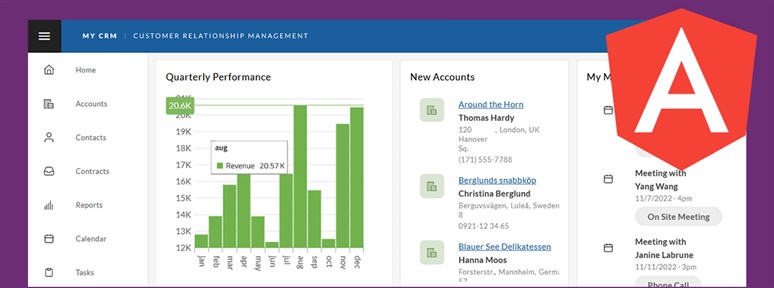
App Builder로 Angular CRM 앱을 구축하는 방법
이 블로그 게시물에서는 WYSIWYG App Builder ™ 사용하여 샘플 및 로우 코드 개발 접근 방식을 사용하여 사용자 지정 Angular CRM 앱을 빌드합니다. 어떻게 하는지 확인해 보세요.
기능, 확장성, 성능 저하 없이 기능이 풍부한 앱을 구축하고 배포하세요.
App Builder 시도 데모 예약하기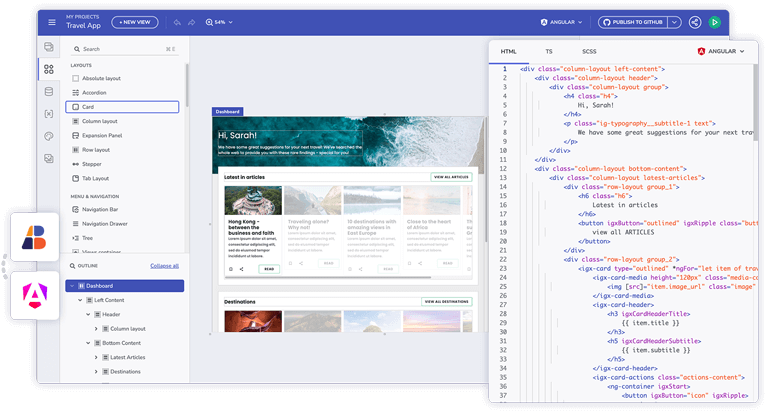
훨씬 더 적은 Angular 코드 줄로 원활한 기능을 구현할 수 있습니다. 오류가 발생하기 쉬운 수동 코딩을 없애고 작업량을 줄여 기능이 풍부한 애플리케이션을 그 어느 때보다 빠르게 제공할 수 있습니다.
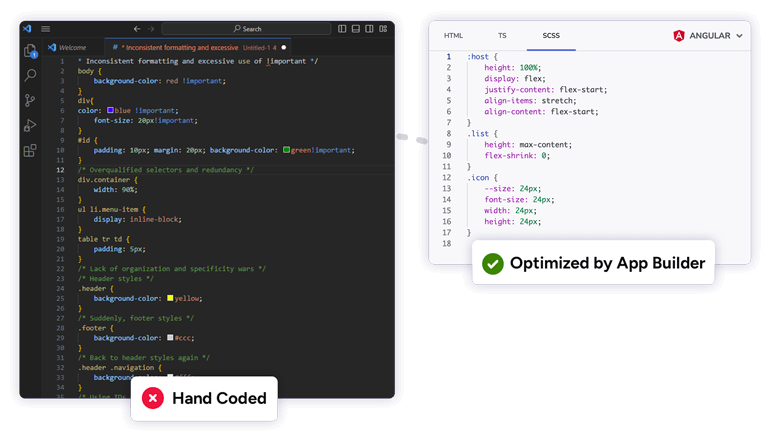
모든 기술 수준의 개발자가 필요한 모든 것을 쉽게 구성할 수 있는 수단을 제공하는 드래그 앤 드롭 인터페이스를 통해 멋진 Angular 앱을 만들 수 있도록 지원합니다. 65+ UI 구성 요소의 완전한 도구 상자 – 가장 빠른 그리드와 차트로 강조 표시됩니다.
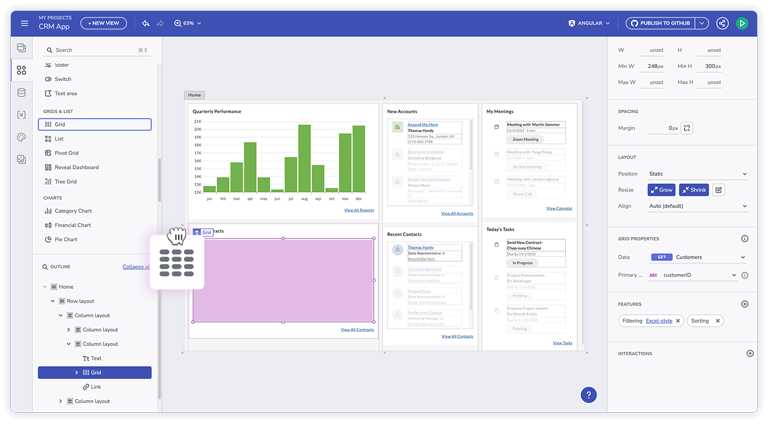
고성능 Angular 애플리케이션을 위한 프로덕션 준비 HTML, TypeScript 및 CSS를 생성합니다. 인스턴트 앱 미리보기를 사용하면 디자인 보기와 코드 보기 간에 전환하여 앱의 로직을 종합적으로 이해할 수 있습니다.
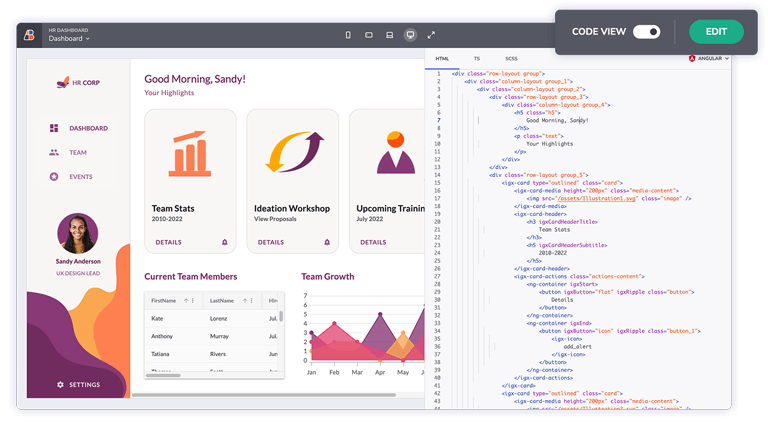
복잡한 코딩 작업을 원활하고 시각적으로 주도되는 경험으로 전환하세요. 모든 고객이 기대하는 기능, 데이터 입력, 전체 CRUD 작업, 마스터 세부 정보, 로컬 및 전역 변수, 라우팅 및 경로 매개변수 등을 제공합니다.
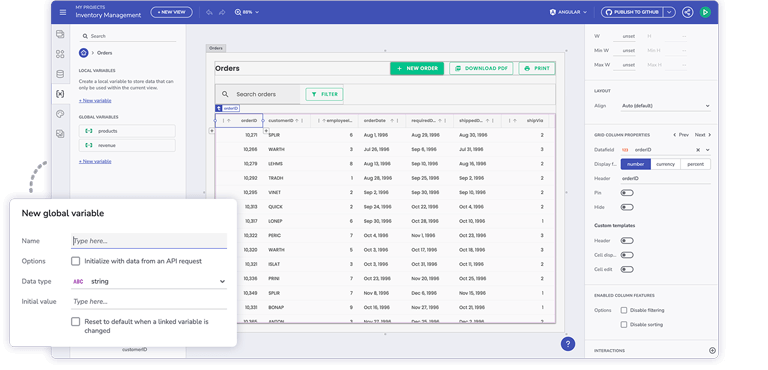
지금 이 영감을 주는 앱 샘플을 탐색하여 효율성을 최적화하고 Angular 프로젝트를 새로운 차원으로 끌어올리십시오.
Angular App Builder는 몇 번의 클릭만으로 Angular 위한 깔끔하고 프로덕션 준비가 완료된 코드를 생성하여 반복적이고 오류가 발생하기 쉬운 작업을 자동화하는 로우 코드 플랫폼입니다. 이를 통해 개발자는 웹 애플리케이션을 구축할 때 시간과 노력을 절약할 수 있으며 최고 경영진은 비즈니스 성장과 디지털 혁신을 더 빠르게 추진할 수 있습니다.
Angular App Builder는 App Builder 통해 팀이 Angular 앱을 구축할 수 있다는 것을 나타내는 또 다른 방법입니다. 실제 Angular 구성 요소를 제공하고 팀이 클릭 한 번으로 프로덕션 준비 Angular 코드를 생성할 수 있습니다.
App Builder 를 Angular UI 빌더/ Angular App Builder 플랫폼으로 사용하면 여러 가지 이점이 있으며 가장 큰 코드 생성의 두 가지 이점은 생산성 향상과 출시 시간 단축입니다. 그러나 여기에 몇 가지 더 있습니다.
생성된 코드는 표준화를 촉진하는 동시에 모범 사례를 따르므로 전체 프로젝트에서 일관성을 유지합니다.
코드나 앱 로직의 품질을 저하시키지 않으면 서 새로운 기능을 추가하고 기존 기능을 확장할 수 있는 확장성과 능력. 이렇게 하면 새로운 요구 사항 및 변경 사항에 따라 앱이 성장할 수 있습니다.
개발자는 처음부터 코드를 작성할 필요가 없으며 한 프레임워크에 대해 생성된 코드를 클릭 한 번으로 다른 프레임워크로 전환할 수 있으므로 시간과 리소스가 절약됩니다.
시각적 인터페이스 및 사전 구축된 구성 요소 제공 화면 디자인, UX 흐름, 테마 및 브랜딩, 데이터 바인딩, 배포 등의 영역에서 수동 및 오류가 발생하기 쉬운 코딩의 필요성을 줄여줍니다. GitHub 통합. 이렇게 하면 다양한 수준의 전문 지식을 갖춘 개발자가 쉽게 애플리케이션을 구축할 수 있습니다.
단일 코드 기반으로 앱을 구축하는 설계 및 개발 부서와 융합 팀을 위한 입증된 단일 솔루션입니다.
전체 디자인-코드 스토리를 단순화하면 디자이너-개발자 핸드오프, 시간 소모적인 POC 및 비용이 많이 드는 반복이 필요하지 않습니다.
즉각적인 코드 생성 및 코드 미리보기를 앱과 나란히 제공하여 앱 로직, Angular 구문 등을 검사할 수 있습니다.
AI 기반 기능을 제공하여 사용자가 간단한 언어 프롬프트에서 이미지와 데이터 소스를 빠르게 생성할 수 있습니다.
생성된 코드를 빠르고 쉽게 사용자 지정할 수 있습니다. App Builder 사용하면 코드가 생성된 앱에서만 플랫폼의 코드를 사용자 지정할 수 있습니다. Angular App Builder를 사용하면 모듈형 앱에서 독립형 앱으로 전환할 수 있으며, 독립형 앱을 위한 하나의 응집력 있는 애플리케이션 구조를 가질 수 있습니다. 코드를 검사하고 독립 실행형 앱이 제대로 작동하는지 확인하면 원하는 환경에 배포할 수 있습니다
Sketch 또는 Figma 디자인 파일을 통합하고 Angular, Blazor 및 Web Components 및 React 용 프로덕션 준비 코드로 변환할 수 있습니다. Sketch 파일을 "기존 디자인에서 만들기" 드롭 영역으로 드래그합니다. Figma 디자인에서 코드를 생성하려면 Figma 플러그인을 사용해야 합니다.
App Builder는 프로덕션에 바로 사용할 수 있는 Angular 코드를 제공하는 유일한 WYSIWYG 로우 코드 도구로, 팀이 실제 앱을 정말 빠르게 빌드할 수 있도록 지원합니다. 직관적인 "드래그 앤 드롭" 인터페이스를 통해 플랫폼은 완벽한 제어 기능을 제공하므로 디지털 제품, 디자인 및 개발 팀은 픽셀 기반의 Angular 앱을 최대 80% 더 빠르게 제공하는 동시에 고객 만족도를 최대 35%까지 높일 수 있습니다.
실제 UI 구성 요소 및 코드 생성 기능을 갖춘 App Builder는 Angular UI 빌더로 작동하므로 수동 코딩 없이 엔터프라이즈급 애플리케이션의 프로토타입을 쉽게 제작, 반복 및 배포할 수 있습니다.
신뢰할 수 있는 단일 소스로 작동하는 이 Angular App Builder 고성능 웹 애플리케이션을 구축하고 유지 관리할 때 보다 효율적으로 협업하고자 하는 모든 기술 수준의 개발자(시민 개발자 포함) 및 융합 팀에서 사용할 수 있습니다.
또한 CTO, CIO, 개발 팀 리더, 엔터프라이즈 엔지니어 및 개발 프로세스를 감독 및 관리하고, 비즈니스 목표 및 기술 표준에 부합하고, 혁신을 주도해야 하는 기타 경영진에게도 적합합니다.
누구나 App Builder 사용할 수 있지만, 여전히 거쳐야 할 몇 가지 중요한 사항과 단계가 있을 수 있습니다. 직관적인 드래그 앤 드롭 인터페이스, 쉽게 사용자 정의할 수 있는 사전 구축된 구성 요소 및 다양한 학습 리소스(포괄적인 문서, 비디오 튜토리얼, 방법 가이드 및 지원 팀) 덕분에 로우 코드 사용 방법을 학습할 수 있습니다. 도구는 간단하고 빠릅니다.

이 블로그 게시물에서는 WYSIWYG App Builder ™ 사용하여 샘플 및 로우 코드 개발 접근 방식을 사용하여 사용자 지정 Angular CRM 앱을 빌드합니다. 어떻게 하는지 확인해 보세요.
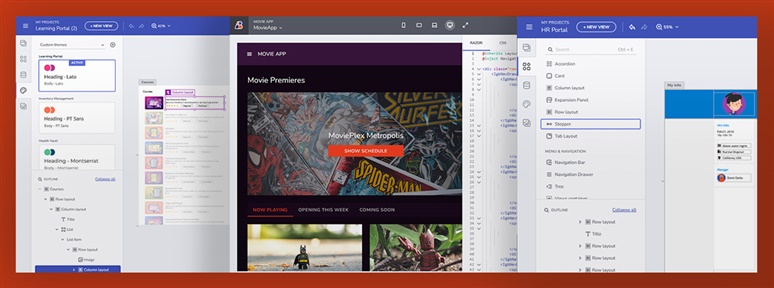
때로는 Angular 프로젝트를 처음부터 시작할 필요가 없습니다. 샘플 응용 프로그램을 사용하고 추가 사용자 지정을 통해 직접 만들 수 있습니다. 이 문서에서는 시작하는 데 도움이 되는 몇 가지 예를 제공합니다.
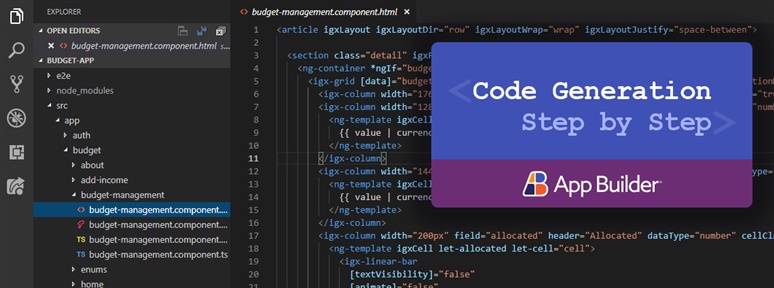
이 단계별 가이드를 읽고 로우 코드로 클릭 한 번으로 Angular 프로덕션에 바로 사용할 수 있는 코드를 생성하는 방법을 알아보세요.